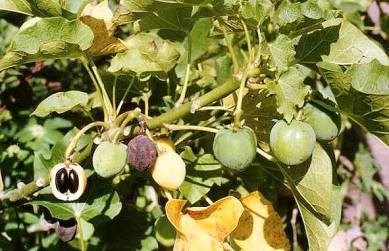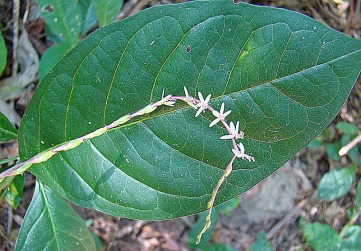This month’s post looks at the links between the Physic Nut tree (Jatropha curcas) and Christ’s crucifixion. However, I’m starting on a more prosaic note. In “Jamaican Ethnobotany”, Martha Warren Beckwith wrote that Physic Nut was “Used generally as a purgative”. As well as being an emetic, according to the Plants for the Future website, Physic Nut has many other healing properties. Here are just a few of them:
“The leaves … can be used to treat a wide range of medicinal conditions such as coughs, convulsions, jaundice, fevers, rheumatic pains, guinea worm sores, wounds and cuts, sores, etc. The seeds can be used as a purgative but only in small doses. Oil obtained from the seeds are used in the treatment of skin diseases and rheumatic pains. It also stimulates hair growth. The root bark is used for sores, dysentery, and jaundice.”
Plants for a Future also warn that all parts of the plant are poisonous.

Aside from its medicinal properties, the Physic Nut has strong associations in the Caribbean with Christ’s crucifixion. For example, in the book Bush Doctor which lists examples of the lore surrounding Caribbean plants, Sylvester Ayre calls the tree the Crucifixion Tree, stating that: “according to believers the red blood-like substance that oozes from the tree when cut at Easter, symbolizes the blood Christ shed on the cross, which was reputedly made of physic wood”.
When doing her Caribbean research in the early 1920s, Martha Beckwith was told of the Physic Nut tree’s propensity to bleed on Good Friday at 12 noon and one of her Pukkumerian informants who had tried this herself, said to Beckwith that the substance oozing from the wood “ really was blood’”.
Next time…. I’ll be looking at the folklore surrounding a few other trees whose wood was believed to have been used for Christ’s Cross.
Sources (in order of appearance in post)
Martha Warren Beckwith, “Jamaica Ethnobotany” in Martha Warren Beckwith, with music recorded in the field by Helen H. Roberts, Jamaica Folklore (New York: The American Folk-Lore Society, 1928), p. 24.
“Plants for a Future” – https://pfaf.org/user/Plant.aspx?LatinName=Jatropha+curcas
Sylvester Ayre, Bush Doctor: Jamaica and the Caribbean’s Almost Forgotten Folklore and Remedies (Kingston, Jamaica: LMH Publishing Limited, 2002), p. 10.
Martha Warren Beckwith, Black Roadways: A Study of Jamaica Folk Life (reprint, New York: Negro Universities Press, 1969, of orig. edn, Chapel Hill: University of North Carolina Press, 1929), p. 40.
Image credits: Photograph of West African Jatropha curcas by R.K. Henning at http://www.Jatropha.org
